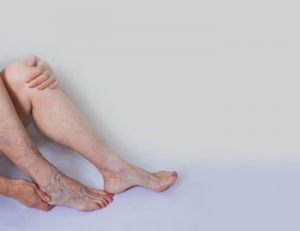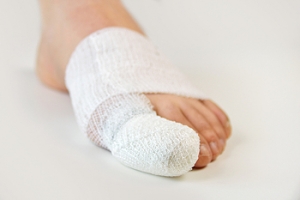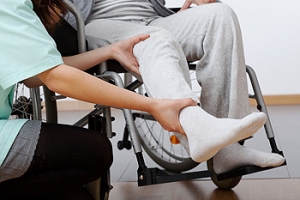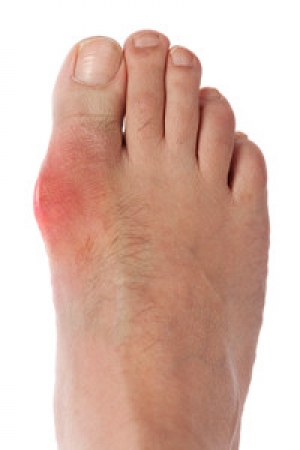Dallas Metro / North Texas
(214) 710-1028
Super User
Where Are Plantar Warts Located?
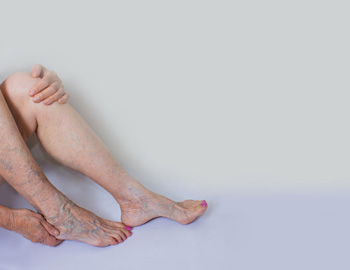 A plantar wart differs from other warts because it is found on the heel of the foot. It is known to grow inward as a result of pressure that is put on the heel while walking and can cause severe pain and discomfort. This type of wart is considered to be contagious, and it is suggested to speak to your child about refraining from sharing shoes and towels. It appears as a small, hardened area of skin, and may have black dots in the center. If the wart begins to spread or causes chronic pain, it is suggested that you speak to a podiatrist who can recommend effective methods of treatments. These may include applying prescribed medication, or possibly injecting the site with specific medicine. It is strongly recommended that your child keep all follow-up appointments, which may aid in attaining a complete recovery.
A plantar wart differs from other warts because it is found on the heel of the foot. It is known to grow inward as a result of pressure that is put on the heel while walking and can cause severe pain and discomfort. This type of wart is considered to be contagious, and it is suggested to speak to your child about refraining from sharing shoes and towels. It appears as a small, hardened area of skin, and may have black dots in the center. If the wart begins to spread or causes chronic pain, it is suggested that you speak to a podiatrist who can recommend effective methods of treatments. These may include applying prescribed medication, or possibly injecting the site with specific medicine. It is strongly recommended that your child keep all follow-up appointments, which may aid in attaining a complete recovery.
Plantar warts can be very uncomfortable. If you need your feet checked, contact Kellvan Cheng, DPM from Elite Foot & Ankle. Our doctor will assist you with all of your foot and ankle needs.
About Plantar Warts
Plantar warts are the result of HPV, or human papillomavirus, getting into open wounds on the feet. They are mostly found on the heels or balls of the feet.
While plantar warts are generally harmless, those experiencing excessive pain or those suffering from diabetes or a compromised immune system require immediate medical care. Plantar warts are easily diagnosed, usually through scraping off a bit of rough skin or by getting a biopsy.
Symptoms
- Lesions on the bottom of your feet, usually rough and grainy
- Hard or thick callused spots
- Wart seeds, which are small clotted blood vessels that look like little black spots
- Pain, discomfort, or tenderness of your feet when walking or standing
Treatment
- Freezing
- Electric tool removal
- Laser Treatment
- Topical Creams (prescription only)
- Over-the-counter medications
To help prevent developing plantar warts, avoid walking barefoot over abrasive surfaces that can cause cuts or wounds for HPV to get into. Avoiding direct contact with other warts, as well as not picking or rubbing existing warts, can help prevent the further spread of plantar warts. However, if you think you have developed plantar warts, speak to your podiatrist. He or she can diagnose the warts on your feet and recommend the appropriate treatment options.
If you have any questions please feel free to contact our office located in Carrollton, TX . We offer the newest diagnostic and treatment technologies for all your foot and ankle needs.
All About Plantar Warts
Plantar warts are warts that are only found on the feet, hence the term “plantar”, which means “relating to the foot.” They are caused by the human papillomavirus, or HPV, and occur when this virus gets into open wounds on the feet. The warts themselves are hard bumps on the foot. They are easily recognizable, mostly found on the heels or ball of the foot. Plantar warts are non-malignant, but they can cause some pain, discomfort, and are often unsightly. Removing them is a common step toward treating them.
Plantar warts can cause some pain while standing, sometimes felt as tenderness on the sole of your foot. Unless the wart has grown into the foot behind a callus, you will be able to see the fleshy wart. A podiatrist should only be consulted if there is an excessive amount of pain. Plantar warts are not cancerous or dangerous, but they can affect your walking and continually reappear. Anyone who suffers from diabetes or a compromised immune system disease should seek out care immediately.
Podiatrists are easily able to diagnose plantar warts. They usually scrape off a tiny bit of the rough skin to make tiny blood clots visible and examine the inside of warts. However, a biopsy can be done if the doctor is not able to diagnose them from simply looking at them. Although plantar warts usually do not require an excessive amount of treatment, there are ways to go about removing them. A common method is to freeze them off using liquid nitrogen, removing them using an electrical tool, or burning them off via laser treatment. For a less invasive treatment option, topical creams can be used through a doctor’s prescription. This treatment method takes more time, however. Keep the wart covered for protection in between daily treatments.
The best way to avoid developing plantar warts is to avoid walking barefoot in public places. Avoid this especially if you have open sores or cuts on your feet. It is also important to avoid direct contact with warts in general, as they are highly contagious.
Choosing the Right Sneakers for Your Feet
 If you plan to go on a run, you should ensure that the shoes you choose to wear fit your feet properly. Running not only impacts your feet, but it also affects your hips, knees, spine, and shoulders. Consequently, it is important that you wear shoes that offer support for your feet. When shopping for a new pair of sneakers, you should ask yourself, “Is the brand I am currently wearing comfortable for my feet?” If you can answer this question with “Yes”, then there may not be a reason for your to switch brands. However, if you do not feel comfortable with your current shoe brand, you should visit a specialist running shoe store to pick out a new pair of sneakers. There are many different foot shapes such as flat foot, high arch, and normal arch. You should try to figure out your foot shape because you may need to wear custom orthotics to correct an abnormal arch.
If you plan to go on a run, you should ensure that the shoes you choose to wear fit your feet properly. Running not only impacts your feet, but it also affects your hips, knees, spine, and shoulders. Consequently, it is important that you wear shoes that offer support for your feet. When shopping for a new pair of sneakers, you should ask yourself, “Is the brand I am currently wearing comfortable for my feet?” If you can answer this question with “Yes”, then there may not be a reason for your to switch brands. However, if you do not feel comfortable with your current shoe brand, you should visit a specialist running shoe store to pick out a new pair of sneakers. There are many different foot shapes such as flat foot, high arch, and normal arch. You should try to figure out your foot shape because you may need to wear custom orthotics to correct an abnormal arch.
Finding a properly-fitting shoe is important in reducing injuries and preventing foot problems. For more information about treatment, contact Kellvan Cheng, DPM from Elite Foot & Ankle. Our doctor will treat your foot and ankle needs.
Proper Shoe Fitting
A common concern when it comes to foot health, having properly fitted shoes can help prevent injuries to the foot. Out feet affect our posture and gait, which in turn affects the biomechanics and overall bodily structure. With 33 joints, 26 bones, and over 100 ligaments, the potential for serious injury is much greater than one realizes. Although the feet cease growth in adulthood, they still change shape as they mature. Here are some factors to consider when it comes to investing in proper fitting shoes:
- Be sure the shoes fit correctly right away
- Ensure the ball of your foot fits comfortably in the widest portion of the shoes
- Even though they may look fashionable, improper fitting shoes can either create adverse conditions or exacerbate existing ones you may already have
- Walk along a carpeted surface to ensure the shoes comfortably fit during normal activity
Keeping in mind how shoes fit the biomechanics of your body, properly-fitting shoes are vitally important. Fortunately, it is not difficult to acquire footwear that fits correctly. Be sure to wear shoes that support the overall structure of your body. Do your feet a favor and invest in several pairs of well-fitted shoes today.
If you have any questions please feel free to contact our office located in Carrollton, TX . We offer the newest diagnostic and treatment technologies for all your foot and ankle needs.
Proper Shoe Fitting
When it comes to maintaining foot health, wearing properly-fitting shoes is important. While wearing the appropriate pair of shoes may seem like a trivial concern, the reality is that improperly fitted shoes cause an astounding amount of injuries to the feet. The overall structure and the biomechanics of our bodies are directly affected by our posture, gait, and feet. Because of this, pain and discomfort felt throughout the body are often related to a problem in the feet. And, most foot problems usually stem from improper footwear.
Shoes should not be purchased with the expectation that they will easily stretch and contort to the size and shape of your feet. When shopping for footwear, look for shoes that fit correctly and comfortably as soon as you put them on. Do not purchase shoes that are too large or that slip in the heel area when you walk. Do not choose shoes that are loose with the intention of wearing thicker socks to compensate for the space. The widest portion of the shoe, the ball of the foot, must be made sure to fit comfortably in the shoe.
Keeping all of these suggestions in mind may be difficult when shopping and when trying to select from a wide array of different shoes. Nonetheless, your time and money will be wasted if you purchase a pair of shoes that are too uncomfortable for you to actually wear them. After finally selecting and purchasing a pair of shoes, try them on at home. To truly ensure whether or not your shoes fit comfortably with normal activity, walk around on a carpeted surface to determine how they feel on your feet.
The possibility of damaging your feet’s 33 joints, 26 bones, and 100+ ligaments is much higher than many people suspect. Finding an appropriate and properly-fitted pair of shoes is perhaps the single most important action you can take to maintain excellent foot health and help prevent injury. The fact that our feet continue to change with age is one that many people often forget. Even if our feet no longer change in size when we mature, our feet will still change in shape.
If you already have pre-existing foot problems, there is a greater possibility that wearing improperly-fitted shoes will worsen those problems. The good news, however, is that appropriate footwear is not difficult to find. While shopping for shoes, remember that improper footwear can detrimentally affect the feet, the entire body and its biomechanical structure as well. The shoes you wear can greatly impact your legs, back, and entire body, as your posture and gait are related to your feet. Finding and selecting the best properly-fitted shoes is necessary in achieving optimal health.
Symptoms of a Broken Toe
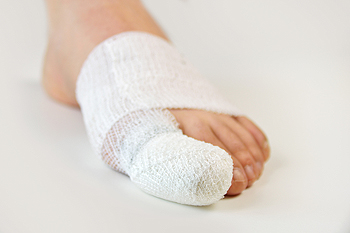 There are several ways a broken toe may occur. These may include dropping a heavy object on the toe, stubbing it on a piece of furniture, or consistent impact that can cause a stress fracture. One of the first symptoms felt may be severe pain. Many people may also notice bruising and swelling around the affected toe and surrounding areas. A cast may be needed if the fracture is severe, and the toe may look deformed. After the injury occurs, it can be beneficial to elevate the foot, and this can be helpful in reducing any swelling that may be present. Some patients find that support and stability may be increased if the affected toe is taped to the toe next to it. As the healing process begins, it is important to rest the foot as often as possible. When the splint or tape is removed, the toe's range of motion can increase as stretching exercises are performed. If you have broken your toe, it is advised that you speak to a podiatrist who can recommend the correct treatment.
There are several ways a broken toe may occur. These may include dropping a heavy object on the toe, stubbing it on a piece of furniture, or consistent impact that can cause a stress fracture. One of the first symptoms felt may be severe pain. Many people may also notice bruising and swelling around the affected toe and surrounding areas. A cast may be needed if the fracture is severe, and the toe may look deformed. After the injury occurs, it can be beneficial to elevate the foot, and this can be helpful in reducing any swelling that may be present. Some patients find that support and stability may be increased if the affected toe is taped to the toe next to it. As the healing process begins, it is important to rest the foot as often as possible. When the splint or tape is removed, the toe's range of motion can increase as stretching exercises are performed. If you have broken your toe, it is advised that you speak to a podiatrist who can recommend the correct treatment.
Broken toes may cause a lot of pain and should be treated as soon as possible. If you have any concerns about your feet, contact Kellvan Cheng, DPM from Elite Foot & Ankle. Our doctor will treat your foot and ankle needs.
What Is a Broken Toe?
A broken toe occurs when one or more of the toe bones of the foot are broken after an injury. Injuries such as stubbing your toe or dropping a heavy object on it may cause a toe fracture.
Symptoms of a Broken Toe
- Swelling
- Pain (with/without wearing shoes)
- Stiffness
- Nail Injury
Although the injured toe should be monitored daily, it is especially important to have a podiatrist look at your toe if you have severe symptoms. Some of these symptoms include worsening or new pain that is not relieved with medication, sores, redness, or open wounds near the toe.
If you have any questions, please feel free to contact our office located in Carrollton, TX . We offer the newest diagnostic and treatment technologies for all your foot care needs.
Obesity May Be a Cause of Plantar Fasciitis
 Research has shown patients who are overweight may develop heel pain. This may be a result of the excess pressure that is exerted on the heel, and may lead to the uncomfortable condition known as plantar fasciitis. Practicing consistent exercise is often recommended to lose additional weight, and this may be difficult to accomplish if chronic heel pain is present. There may be other types of heel pain that can develop as a result of being obese. These may include flat feet, bunions, or certain types of arthritis. If you are overweight, and have chronic foot pain, it is strongly suggested that you seek the counsel of a podiatrist who can properly assist you in treating any foot pain you may have.
Research has shown patients who are overweight may develop heel pain. This may be a result of the excess pressure that is exerted on the heel, and may lead to the uncomfortable condition known as plantar fasciitis. Practicing consistent exercise is often recommended to lose additional weight, and this may be difficult to accomplish if chronic heel pain is present. There may be other types of heel pain that can develop as a result of being obese. These may include flat feet, bunions, or certain types of arthritis. If you are overweight, and have chronic foot pain, it is strongly suggested that you seek the counsel of a podiatrist who can properly assist you in treating any foot pain you may have.
Obesity has become very problematic at this point in time and can have extremely negative effects on the feet. If you’re an obese individual and are concerned about your feet, contact Kellvan Cheng, DPM from Elite Foot & Ankle. Our doctor can provide the care you need to keep you pain-free and on your feet.
Obesity and Your Feet
Since your feet are what support your entire weight when standing, any additional weight can result in pain and swelling. Being overweight is one of the main contributors to foot complications.
Problems & Complications
Extra Weight – Even putting on just a few extra pounds could create serious complications for your feet. As your weight increases, your balance and body will shift, creating new stresses on your feet. This uneven weight distribution can cause pain, even while doing the simplest tasks, such as walking.
Diabetes – People who are overweight are at serious risk of developing type-2 diabetes, which has a drastic impact on the health of your feet. As you get older, your diabetes might worsen, which could lead to loss of feeling in your feet, sores, and bruises. You could also become more prone to various infections.
Plantar fasciitis – Pressure and stress that is placed on muscles, joints, and tendons can trigger plantar fasciitis, which is an inflammation of tissue that forms along the bottom of the foot.
If you have any questions please feel free to contact our office located in Carrollton, TX . We offer the newest diagnostic and treatment technologies for all your foot and ankle needs.
Is Foot Therapy Effective?
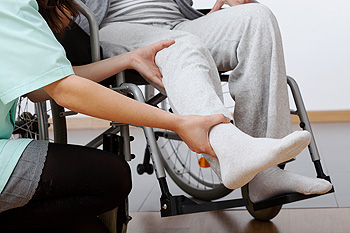 If an injury should occur to the foot or ankle, foot therapy may be an avenue that is pursued to obtain mild relief. There are many foot conditions that would benefit from having physical therapy performed, and these may include plantar fasciitis, or foot and ankle stress fractures. Some patients find it helpful to use this form of therapy to aid in recovering from foot or ankle surgery, and it may help in regaining full range of motion. Additionally, flexibility and overall strength in the feet and ankles may improve when specific muscles are stretched. If you would like to know more about the benefits of foot therapy, please consult with a podiatrist who can properly guide you.
If an injury should occur to the foot or ankle, foot therapy may be an avenue that is pursued to obtain mild relief. There are many foot conditions that would benefit from having physical therapy performed, and these may include plantar fasciitis, or foot and ankle stress fractures. Some patients find it helpful to use this form of therapy to aid in recovering from foot or ankle surgery, and it may help in regaining full range of motion. Additionally, flexibility and overall strength in the feet and ankles may improve when specific muscles are stretched. If you would like to know more about the benefits of foot therapy, please consult with a podiatrist who can properly guide you.
Foot therapy is often necessary for those recovering from either foot deformities or foot injuries. If you have concerns regarding therapy, Kellvan Cheng, DPM of Elite Foot & Ankle. Our doctor can provide the care you need to keep you pain-free and on your feet.
Most Common Injuries
People who are active or athletes are prone to a variety of injuries. Therefore, it is often important to take part in physical therapy in order to quickly get back on the right track.
What to Do When Injured
Physical Therapy – This specialized treatment will focus on the affected area, speeding up recovery and the overall healing process. It is a proven method that has helped millions of people return from any injury.
During physical therapy you will undergo regimented training to get back into full form. Training is often very difficult, especially at first when the foot feels weak. Physical therapy often involves:
Basic stretching and twisting exercises – getting the feet’s mobility and flexibility up.
Massaging – the therapist will massage the injured area in order to activate the muscles and relax them.
Strengthening Exercises – this allows the muscles in the affected area to regain their full strength, a vital step towards full recovery.
If you have any questions please feel free to contact our office located in Carrollton, TX . We offer the newest diagnostic tools and technology to treat your foot and ankle needs.
Foot Therapy for Sports Injuries
Foot Therapy for Sports Injuries
Athletes are used to engaging in high-intensity workouts. Consequently, athletes are at an increased risk for enduring foot or ankle injuries. The most common way to treat these types of injuries is the RICE method (Rest, Ice, Compression, and Elevation). However, braces and casts may be required in some cases. If you are suffering from any of these injuries, it is best that you seek help from your podiatrist right away.
Achilles Tendinitis
Achilles tendinitis is a type of overuse injury of the Achilles tendon, which is the tendon connecting the calf muscles to the heel. This type of injury commonly occurs in runners who increase the intensity of their workouts. Symptoms for this condition start off as a mild ache in the back leg or above the heel. Some people experience tenderness around the area in the morning, however this feeling tends to improve over time. If you suspect you have Achilles tendinitis, you doctor may order an x-ray to show whether your Achilles tendon has calcified. Common treatment options for this condition include rest, ice, exercise, and non-steroidal anti-inflammatory medication.
Plantar Fasciitis
Plantar Fasciitis is a condition that is commonly found in women. It is a painful condition that occurs when the bands of tissue that connect the heel to the toes become inflamed. Symptoms for plantar fasciitis are heel pain that worsens in the morning and improves throughout the day with activity. Your podiatrist will diagnose plantar fasciitis by checking for tender areas on your foot. In rare cases, an x-ray may be required for a more thorough examination. There are various treatment options that may be used to help someone with this ailment. Depending on the specific case, some of these options include: physical therapy, shockwave therapy, and in rare cases, surgery.
Stress Fractures
Stress fractures are tiny cracks in the bone that occur due to repetitive force. These fractures are typically the result of overuse injuries such as repeatedly running and jumping. Symptoms of a stress fracture include pain when exercising, tenderness, and mild swelling. To diagnose a stress fracture, your doctor will likely ask you a series of questions about your overall health and the activities you are involved in. Next, an x-ray will likely be performed to check for the fracture. In some cases, fractures don’t appear on x-rays until weeks afterward. In these cases, an MRI or a bone scan may be required. Typical stress fractures may be treated by resting the area and taking a break from highly intense activities.
Ankle Sprain
Ankle sprains occur when the ligaments that support the ankle are stretched far beyond their limits. These injuries occur when you roll, twist, or turn your ankle in an awkward way. Ligaments are essential in helping us move around because they are responsible for stabilizing the joints. Usually, sprained ankles occur due to ligaments on the outer part of the ankle becoming stretched. Symptoms of ankle sprains are swelling, bruising, instability of the ankle, and restricted range of motion. Normally, when people sprain their ankle, they will hear a popping sound during the injury. Depending on the severity, ankle sprains are graded based on how much damage has occurred to the ligaments. Grade 1 is mild, grade 2 is moderate, and grade 3 is severe.
Gout and Kidney Diseases
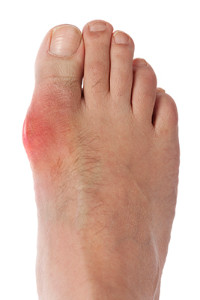 Research has shown the condition that is referred to as gout may be a result of advanced kidney disease. It is a form of arthritis, and a flare-up may cause severe pain and discomfort. This ailment is typically associated with several symptoms, which may include pain, discomfort, and swelling on the side of the big toe. There are different forms of gout, which are classified as acute and chronic. The former type may affect a few joints in the toe, and symptoms will generally disappear when the attack is over. Chronic gout is characterized by having multiple attacks per year, and this may lead to permanent joint damage and deformity. It is advised to refrain from ingesting specific types of foods if you are prone to gout attacks, which may include foods that have high levels of purines such as shellfish, excess alcohol, and red meat. There are certain foods that may lower the uric acid levels in the blood, including fruits and vegetables that have elevated vitamin C levels. If you are afflicted with gout, it is suggested that you speak to a podiatrist who can properly treat this condition.
Research has shown the condition that is referred to as gout may be a result of advanced kidney disease. It is a form of arthritis, and a flare-up may cause severe pain and discomfort. This ailment is typically associated with several symptoms, which may include pain, discomfort, and swelling on the side of the big toe. There are different forms of gout, which are classified as acute and chronic. The former type may affect a few joints in the toe, and symptoms will generally disappear when the attack is over. Chronic gout is characterized by having multiple attacks per year, and this may lead to permanent joint damage and deformity. It is advised to refrain from ingesting specific types of foods if you are prone to gout attacks, which may include foods that have high levels of purines such as shellfish, excess alcohol, and red meat. There are certain foods that may lower the uric acid levels in the blood, including fruits and vegetables that have elevated vitamin C levels. If you are afflicted with gout, it is suggested that you speak to a podiatrist who can properly treat this condition.
Gout is a painful condition that can be treated. If you are seeking treatment, contact Kellvan Cheng, DPM from Elite Foot & Ankle. Our doctor will treat your foot and ankle needs.
What Is Gout?
Gout is a form of arthritis that is characterized by sudden, severe attacks of pain, redness, and tenderness in the joints. The condition usually affects the joint at the base of the big toe. A gout attack can occur at any random time, such as the middle of the night while you are asleep.
Symptoms
- Intense Joint Pain - Usually around the large joint of your big toe, and it most severe within the first four to twelve hours
- Lingering Discomfort - Joint discomfort may last from a few days to a few weeks
- Inflammation and Redness -Affected joints may become swollen, tender, warm and red
- Limited Range of Motion - May experience a decrease in joint mobility
Risk Factors
- Genetics - If family members have gout, you’re more likely to have it
- Medications - Diuretic medications can raise uric acid levels
- Gender/Age - Gout is more common in men until the age of 60. It is believed that estrogen protects women until that point
- Diet - Eating red meat and shellfish increases your risk
- Alcohol - Having more than two alcoholic drinks per day increases your risk
- Obesity - Obese people are at a higher risk for gout
Prior to visiting your podiatrist to receive treatment for gout, there are a few things you should do beforehand. If you have gout you should write down your symptoms--including when they started and how often you experience them, important medical information you may have, and any questions you may have. Writing down these three things will help your podiatrist in assessing your specific situation so that he or she may provide the best route of treatment for you.
If you have any questions, please feel free to contact our office located in Carrollton, TX . We offer the newest diagnostic and treatment technologies for all your foot care needs.
Running and Its Effects on Stress Fractures
 Routinely going for runs offers an abundance of health benefits, but there are also some health risks to watch out for, especially regarding feet. One of the common ailments associated with running is stress fractures. Running results in repetitive pressure being applied to your foot, which can create a small break in the bone. This small break is called a stress fracture. Sadly, sometimes this fracture may not become apparent to the runner immediately and they could be put in a situation where they cause more damage. There could be a feeling of slight discomfort, but the fracture may not be obvious at first. Running on a stress fracture could result in a full-on fracture or full break, so paying attention to what your foot is feeling is important. If you feel that you may have a stress fracture or simply want more information in order to avoid getting one in the future, then it is suggested you consult with a podiatrist.
Routinely going for runs offers an abundance of health benefits, but there are also some health risks to watch out for, especially regarding feet. One of the common ailments associated with running is stress fractures. Running results in repetitive pressure being applied to your foot, which can create a small break in the bone. This small break is called a stress fracture. Sadly, sometimes this fracture may not become apparent to the runner immediately and they could be put in a situation where they cause more damage. There could be a feeling of slight discomfort, but the fracture may not be obvious at first. Running on a stress fracture could result in a full-on fracture or full break, so paying attention to what your foot is feeling is important. If you feel that you may have a stress fracture or simply want more information in order to avoid getting one in the future, then it is suggested you consult with a podiatrist.
Activities where too much pressure is put on the feet can cause stress fractures. To learn more, contact Kellvan Cheng, DPM from Elite Foot & Ankle. Our doctor can provide the care you need to keep your pain free and on your feet.
Dealing with Stress Fractures of the Foot and Ankle
Stress fractures occur in the foot and ankle when muscles in these areas weaken from too much or too little use. The feet and ankles then lose support when walking or running from the impact of the ground. Since there is no protection, the bones receive the full impact of each step. Stress on the feet can cause cracks to form in the bones, thus creating stress fractures.
What Are Stress Fractures?
Stress fractures occur frequently in individuals whose daily activities cause great impact on the feet and ankles. Stress factors are most common among:
- Runners
- People affected with Osteoporosis
- Tennis or basketball players
- Gymnasts
- High impact workouts
Symptoms
Pain from the fractures occur in the area of the fractures and can be constant or intermittent. It will often cause sharp or dull pain with swelling and tenderness. Engaging in any kind of activity which involves high impact will aggravate pain.
If you have any questions please feel free to contact our office located in Carrollton, TX . We offer the newest diagnostic and treatment technologies for all your foot and ankle needs.
Featured Articles
- June 2025
- May 2025
- April 2025
- March 2025
- February 2025
- January 2025
- December 2024
- November 2024
- October 2024
- September 2024
- August 2024
- July 2024
- June 2024
- May 2024
- April 2024
- March 2024
- February 2024
- January 2024
- December 2023
- November 2023
- October 2023
- September 2023
- August 2023
- July 2023
- June 2023
- May 2023
- April 2023
- March 2023
- February 2023
- January 2023
- December 2022
- November 2022
- October 2022
- September 2022
- August 2022
- July 2022
- June 2022
- May 2022
- April 2022
- October 2019
- September 2019
- August 2019
- July 2019
- June 2019
- May 2019
- April 2019
- March 2019
- February 2019
- January 2019
- December 2018
- November 2018
- October 2018
- September 2018
- August 2018
- July 2018
- June 2018
- May 2018
- April 2018
- March 2018
- February 2018
- January 2018
- December 2017
- November 2017
- October 2017

